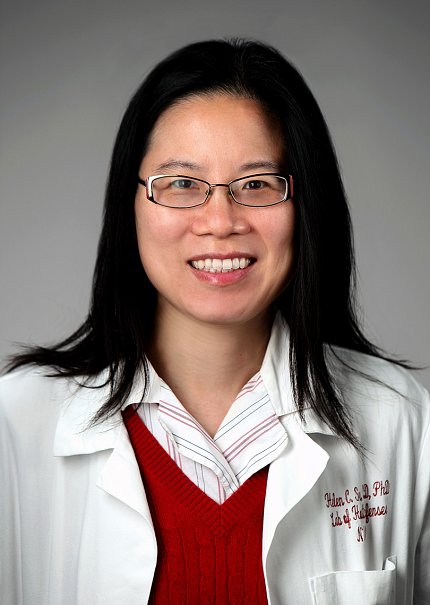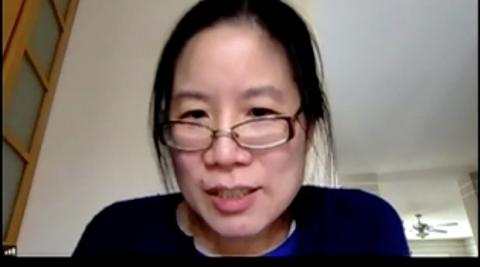A Nimble IRP Responds
Su Examines Genetic Susceptibility to Severe Covid-19 Infection

When the global pandemic caused by a novel coronavirus made its debut in late 2019, NIAID’s Dr. Helen Su was studying inborn errors of immunity in patients with viral infections, mostly rhinoviruses, which cause colds, and influenza. Why, she wondered, was there such variability of outcomes in people infected with the same virus?
In a remarkable example of the NIH Intramural Research Program’s nimbleness, she and her colleagues quickly pivoted to studies of SARS-CoV-2 when it became apparent that Covid-19, the disease caused by the virus, was spreading fast and becoming, in at least a small portion of patients, life-threatening.
By now, most people know the risk factors for Covid infection: advanced age, obesity, pre-existing cardiovascular and pulmonary issues, “and, I’m sorry to say,” continued Su, “being male.”
To that list can be added two informative outliers, she said: Those with a monogenic predisposition to get very sick, and their opposite—those whose genetic makeup seems to confer protection.
Su, who is chief of the human immunological diseases section in the Laboratory of Clinical Immunology and Microbiology, has joined forces with 15 principal investigators from 4 NIH institutes and centers to better understand Covid-19 pathogenesis, especially in those patients suffering acute respiratory syndrome.
As part of the Covid Human Genetic Effort, co-led by Dr. Jean-Laurent Casanova at the Rockefeller University, HHMI and INSERM, and NIAID’s Covid-19 Consortium, they are also working closely with investigators at the Uniformed Services University of the Health Sciences, New York, Paris and clinical teams in Italy to generate mountains of data on innate responses to infection.
“We had the freedom to sequence whoever we wanted to, regardless of age,” said Su. “We sequenced all comers.”
Mostly clinical immunologists, the team is looking for genetic variants responsible for acute disease. They have identified several loci of interest, in pathways involving type 1 and type 3 interferon, which are involved in susceptibility to respiratory viruses.
“It has been a thrill and an honor to watch our PIs apply their diverse talents to this pandemic,” noted NIAID scientific director Dr. Steve Holland, who introduced Su’s recent lecture—the 20th episode in a series begun last spring by the NIH Covid-19 scientific interest group. “It’s been incredible to watch the fury and the enthusiasm with which this has been attacked.”

Death is not a frequent or common outcome of covid infection, but neither is it extremely rare, said Su.
Sifting the human immune system for vulnerabilities to Covid-19 is no easy task.
“The immune system is extremely complex and dynamic,” said Su. “When it is unleashed, it is a powerful force.”
At least 1,800 genes are involved in immune function, she said. And there are more than 420 distinct diseases where scientists know the underlying genetic lesion.
Inborn errors of immunity—Su’s specialty—are estimated to affect about 1 in 4,000 live births. They can be grouped into categories, depending on which arms of the immune system are affected.
“It’s not just white blood cells,” Su explained, but also “intrinsic immunity, involving many kinds of cells not typically thought of as immune-related.”
The investigators found that impaired type 1 interferon production is associated with worse Covid-19 disease. Patients with this defect were more likely to require ventilator support.
The team focused on 13 genes that are important to type 1 interferon response, gathering both whole genome and whole exome data. They found that more than 3 percent of seriously ill patients had deleterious mutations in a number of these genes, resulting in loss of function.
Narrowing their focus to just 3 genes—IRF7, IFNAR 1 and IFN-alpha2—the investigators examined more than 1,000 patients critically ill with Covid-19, using as a comparison group more than 600 patients who were either asymptomatic or had mild cases, in addition to 1,200 healthy controls.
In about 10 percent of those seriously ill, autoantibodies to type 1 interferons were found—their own immune systems were neutralizing their ability to respond to SARS-CoV-2.
“These are really potent neutralizing autoantibodies to certain cytokines,” said Su. “They exert a lot of biological function. And they are over-represented among men and older patients.”
She admitted, “There is a lot we still don’t know about autoantibodies, but they do predispose people to infection.” She estimates that about 10 percent of critically ill Covid-19 patients have neutralizing autoantibodies.
“Knowing the defects allows us to better treat these patients,” she explained.
It is not yet clear whether administering interferons directly would be helpful, or if neutralizing autoantibodies can be removed by plasmapheresis, she said.
“Loss of interferon function early in infection is not good,” Su concluded. “But there is still a lot to be understood…Too much and too little interferon are both bad things.”
In a brief Q&A session, Su was asked if there are genetic or antibody tests that could signal a person at higher risk of severe Covid disease.
“Technically, it would not be very hard to do,” she said, “but the interpretation is a little more difficult. What do you actually tell a person about risk? We need more research for concrete answers. Even if a person has a genetic defect, there is variable penetrance. It’s not clear what kind of information would be actionable.”
The full lecture is available at https://videocast.nih.gov/watch=38875.
